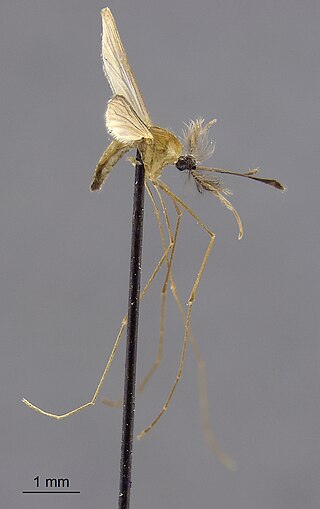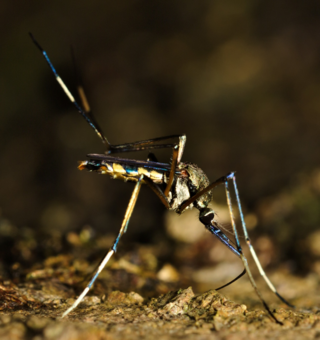Related Research Articles

Culex (Culex) tritaeniorhynchus is a species of mosquito and is the main vector of the disease Japanese encephalitis. This mosquito is a native of northern Asia, and parts of Africa. Females target large animals for blood extraction, including cattle and swine, and are strongly anthropophilic.

Bradinopyga geminata is a species of dragonfly in the family Libellulidae known commonly as the granite ghost. It is native to India, Sri Lanka and Thailand, where it is a common and widespread species.
Lutzia is a genus of mosquitos. First described in 1903 by Frederick Vincent Theobald, it includes species whose larval stages exhibit predatory behavior. The type species is Lutzia bigoti.
Lutzia fuscana is a mosquito that is predatory in its larval stages. It has been investigated as a possible biological control agent, showing some promise where vector species share limited or specific breeding habitat.

Anopheles insulaeflorum is a species complex of mosquito belonging to the genus Anopheles. It is found in India, Sri Lanka, Cambodia, China, Indonesia, Malaysia, Myanmar, Philippines, Taiwan, Thailand, and Vietnam.
Anopheles (Anopheles) reidi is a species complex of barbirostris mosquito belonging to the genus Anopheles. It is endemic to Sri Lanka.
Anopheles (Cellia) tessellatus is a species complex of zoophilic mosquito belonging to the genus Anopheles. It is found in India, and Sri Lanka, Bangladesh, Cambodia, China, Indonesia, Malaysia, Laos, Maldives, Myanmar, Nepal, Philippines, Taiwan, Thailand and Vietnam. It is first described from Sri Lanka. Larvae are known to found from dirty stagnant water in sun or shady habitats. Adults are zoophilic. It is not regarded as a malaria vector, but is a secondary vector of Wuchereria bancrofti in Maldives.
Armigeres (Armigeres) aureolineatus is a species complex of zoophilic mosquito belonging to the genus Armigeres. It is found in Sri Lanka, India, Malaya, Cambodia, Laos, Nepal, Philippines, Vietnam, Thailand, Indochina, China, and Borneo. Larvae are collected from discarded containers, coconut shells and dirty water pools. It is known as a vector for avian diseases and few mammalian diseases.

Toxorhynchites (Toxorhynchites) splendens is a species of non-hematophagous mosquito belonging to the genus Toxorhynchites. It is widely used as a predator to control dengue mosquitoes.
Culex (Culiciomyia) fragilis is a species of mosquito belonging to the genus Culex. It is found in India, Sri Lanka, Borneo, Malaysia, Cambodia, Indonesia, Malaysia, New Guinea (Island); Papua New Guinea, Philippines, Solomon Islands, Thailand, and Vietnam.

Culex (Culex) gelidus is a species of mosquito belonging to the genus Culex. It is found in India, Sri Lanka, Bangladesh, Cambodia, China, Hong Kong, India, Indonesia, Japan, Laos, Malaysia, Myanmar, Nepal, New Guinea (Island); Papua New Guinea, Pakistan, Philippines, Taiwan, Thailand, Vietnam. In 1976, it was identified as a major vector of Japanese encephalitis virus, in India. From an experiment, it was evident that aqueous solution of Calotropis gigantea leaves possess larvicidal activity, mosquito repellent activity and ovicidal activity against Culex gelidus.
Culex (Lutzia) halifaxi is a species of mosquito belonging to the genus Culex. It is found in Australia, New Zealand, Indonesia and Sri Lanka
Culex (Lophoceraomyia) infantulus is a species of mosquito belonging to the genus Culex. It is found in Cambodia, China, Hong Kong, India, Indonesia, Japan, South Korea, Malaysia, Maldives, Myanmar, Nepal, Philippines, Sri Lanka, Thailand, and Vietnam.
Culex (Oculeomyia) infula is a species of mosquito belonging to the genus Culex. It is found in Bangladesh, India, Indonesia, Malaysia, Myanmar, Nepal, Philippines, Singapore, Sri Lanka, Thailand, and Vietnam. Adults mainly feeds on cattle but infrequently shows a low proportion of human and bird blood meals. Larvae can be found in water courses with high content of algal populations. In 1998, the species was identified as a vector of Japanese encephalitis virus.
Culex (Lophoceraomyia) mammilifer is a species of mosquito belonging to the genus Culex. It is found in Cambodia, China, India, the Andaman Islands, Indonesia, Malaysia, Philippines, Sri Lanka, and Thailand.
More infoCulex (Culiciomyia) nigropunctatus is a species of mosquito belonging to the genus Culex. It is found in Bangladesh, Borneo, Malaysia, Cambodia, China, Hong Kong, India, Indonesia, Japan, Laos, Malaysia, Micronesia, Nepal, Palau, Philippines, Singapore, Sri Lanka, Thailand, Taiwan, and Vietnam.
Culex (Eumelanomyia) pluvialis is a species of mosquito belonging to the genus Culex. It is found in India, Malaysia and Sri Lanka.
Culex (Culex) pseudovishnui is a species complex of mosquito belonging to the Culex vishnui group of the genus Culex. It is found in Bangladesh, Cambodia, China, Hong Kong, India, Indonesia, Iran, Iraq, Japan, South Korea, Laos, Macau, Malaysia, Nepal, New Guinea (Island); Papua New Guinea, Pakistan, Philippines, Singapore, Sri Lanka, Thailand, Taiwan and Vietnam. It is a major vector of West Nile virus, and Japanese encephalitis virus
Culex (Culiciomyia) spathifurca is a species of mosquito belonging to the genus Culex. It is found in Cambodia, India, Indonesia, Malaysia, Maldives, Borneo, Java, Philippines, Philippines, Singapore, Sri Lanka, Irian Jaya, Maluku, and Thailand. This mosquito shows unique male terminalia with bifurcate gonostylus, which can used to differentiate it from other species. Larva and pupa can be found in tree holes associated with mangrove ecosystems. It is a potential vector of Wuchereria bancrofti, but human bitings are very rare.
References
- ↑ "Invasion of the predatory mosquito Culex (Lutzia) fuscanus in the western desert parts of Rajasthan, India". National Institute of Malaria Research. Retrieved 3 February 2017.
- ↑ "An annotated checklist of mosquitoes of Sri Lanka" (PDF). Man and Biosphere Reserve of Sri Lanka. Archived from the original (PDF) on 25 June 2016. Retrieved 3 February 2017.
- ↑ "Species Details : Culex bahri (Edwards, 1914)". Catalogue of Life. Retrieved 3 February 2017.
- ↑ Surendran, SN; Jude, PJ; Thavaranjit, AC; Eswaramohan, T; Vinobaba, M; Ramasamy, R (2013). "Predatory efficacy of Culex (Lutzia) fuscanus on mosquito vectors of human diseases in Sri Lanka". Journal of the American Mosquito Control Association. 29 (2): 168–70. doi:10.2987/12-6321R.1. PMID 23923332. S2CID 760413.